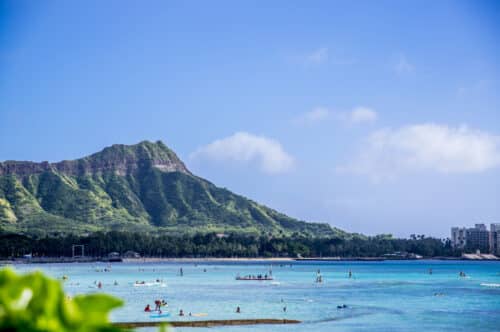Waikiki, a sun-kissed paradise on the shores of Oahu, Hawaii, is not only renowned for its pristine beaches and swaying palm trees but is also eternally linked with the rich tapestry of surfing history. As the birthplace of modern surfing, Waikiki’s shores have witnessed the evolution of this ancient Polynesian art into a global phenomenon. Join us as we ride the waves of time to explore the captivating history of surfing in Waikiki.

Ancient Roots: Long before the first Western explorers set foot on the Hawaiian Islands, the ancient Hawaiians embraced surfing as an integral part of their culture and spirituality. Known as “he’e nalu” in the Hawaiian language, surfing was not merely a recreational activity but held deep cultural significance. Waikiki, with its gentle rolling waves and warm Pacific waters, became a natural playground for Hawaiians to practice and refine their surfing skills.
Duke Kahanamoku: A Surfing Icon: The turning point in the history of Waikiki surfing came with the legendary Duke Kahanamoku. Born in 1890, Duke was not only an Olympic swimmer but also a true ambassador of Hawaiian aloha spirit. Often referred to as the “Father of Modern Surfing,” Duke played a pivotal role in introducing surfing to the world beyond Hawaii.
In the early 20th century, Duke and other Waikiki beach boys showcased their exceptional surfing skills, catching the attention of onlookers and sparking global interest in the sport. Duke Kahanamoku’s fame and charisma brought surfing to international prominence, forever associating Waikiki with the sport’s genesis.
Waikiki Beach Boys: Guardians of the Surf Culture: Waikiki’s surf culture was further shaped by the iconic figures known as the Waikiki Beach Boys. These skilled watermen, often of Native Hawaiian descent, served as instructors, guides, and entertainers for visitors flocking to Waikiki in the early 20th century. Their intimate connection with the ocean and mastery of surfing techniques helped cultivate the allure of Waikiki as a surfing destination.
These Beach Boys not only taught the art of surfing to eager novices but also played a crucial role in preserving and passing down the traditional Hawaiian values associated with the sport. With their distinctive outrigger canoes and wooden surfboards, the Waikiki Beach Boys became synonymous with the vibrant surf culture that still resonates along these shores.
Surfing’s Golden Age: The mid-20th century marked a golden age for surfing in Waikiki. Hollywood films and popular media celebrated the sport, turning Waikiki into a must-visit destination for surf enthusiasts. The laid-back atmosphere, warm hospitality, and the allure of riding the gentle waves of Waikiki attracted surfers from around the world. The Waikiki beaches transformed into a melting pot of surf cultures, where surfboards became the passports to an endless summer of waves and camaraderie.
The Evolution of Surfing Culture: As the decades rolled on, surfing in Waikiki evolved along with the global surfing culture. Shortboards, innovative surfing techniques, and the rise of professional surfing competitions found a home in Waikiki. The sport that once echoed ancient Hawaiian traditions had now become a dynamic, international phenomenon, yet Waikiki remained at its heart.
Today, as surfers from various skill levels share the waves along Waikiki’s shores, the history of surfing is palpable. The echoes of Duke Kahanamoku’s laughter, the wisdom of the Beach Boys, and the timeless connection between the people and the ocean continue to shape Waikiki’s identity as a surfing haven.
Conclusion: Waikiki stands as a living testament to the enduring legacy of surfing. From its ancient roots to the global phenomenon it is today, the waves of Waikiki have carried the spirit of aloha across generations. As surfers paddle out into the azure waters, they become part of a narrative that transcends time—a story woven by the sea, the sun, and the vibrant history of Waikiki, where the art of riding waves became a way of life.
